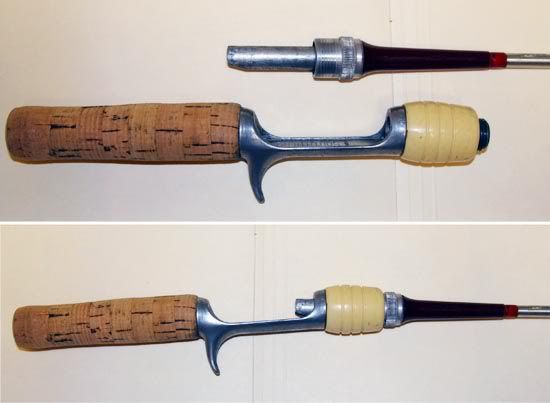A Different Sort of Rod
Recently at the Greater Milwaukee Antique Tackle Show I purchased sizable bundle of metal casting rods that were sold as a group in the silent auction. I really only wanted one rod in the group, a seamless hollow steel casting rod that bore the Pfleuger name but was obviously made for them by True Temper. I was well pleased with the Pfleuger rod as it will partner well with a Shakespeare Marhoff reel for some vintage tackle fishing next summer. The rest of the bundle appeared to be a lot of mismatched and frankly worthless junk. There was however one rod in the group that struck me as something different. I could see the South Bend name cast in the reel seat of the handle but the decal was missing from the base of the rod. The rod was a bright aluminum color almost like stainless steel. I could make out a slight “step-down” taper and assumed it was seamless tubular steel. Upon closer inspection when I arrived home it felt a little light so I took out a magnet and sure enough it did not stick to the rod.
I have spent a good deal of time pondering this unusual rod. What is it made of and is it indeed hollow? The rod is also is topped off by one of the more unusual handle and reel seat arrangements I've seen. I called on South Bend researcher Marie Munson and asked her if she was familiar with this rod. After searching through her catalogs she told me that the 1951 catalog contained a listing for a rod that sounded like it might be the one in question. Using this as a guide, I started searching for advertisements from that period. After a lot of looking over a two week period I came across two ads in the spring of 1947 for the rod which it turns out is called the "411 South Bender". The advertisement reproduced here is from the March,1947 issue of Sports Afield. Unfortunately it only tells us that the rod is made from a “new, tough metal alloy” and that the rod tip weights only 3 oz.

My best guess as to the material that the rod is made from is beryllium-copper which immediately after World War II was thought to be the next miracle material for a lot of things including fishing rods. At least one other company offered beryllium-copper rods in an aluminum colored finish and that would explain the color of my rod. The following ad from the Warren Products Corp. appeared in the same magazine. It is one of the few companies to advertise beryllium-copper rods. Beryllium-copper did make a wonderfully light, strong fishing rod with nice action. The Champion Products Company offered its' telescoping beryllium-copper “Handle Rod” well into the early 1960s and the material was well suited to that design. However beryllium-copper's life as a general rod material was cut short almost before it got started by the advent of fiberglass. It wasn't that fiberglass was that much superior to beryllium-copper, but it was much cheaper to produce and could more easily be made into rod blanks with widely differing actions..

Getting back to my "411South Bender" metal rod. Its unusual handle design uses the ferrule at the base of the rod blank as the locking devise to secure the reel, the rod itself being drawn back through the handle by turning a metal collar that threads onto the handle. This arrangement does not allow for the standard offset reel seat which was almost universal at that time. Somewhat the same effect was achieved by tilting the handle downward at the front edge of the reel seat. Marie was kind enough to send me a copy of the 1951 South Bend catalog. It is there that I learned that handle is euphemistically called "semi-offset" and that the rod is indeed solid metal despite being as thick as the average solid glass rod. All in all, a pretty unique arrangement that can best be understood looking at the following pictures.

-- Bill Sonnett
Enjoy reading your post and your fishing experience with fly rods and still used awesome, Get latest ODM rods belts and bags at wholesale prices.
ReplyDeleteHey I found a rod copper telescoping rod made by south bend..anybody what it is
ReplyDelete